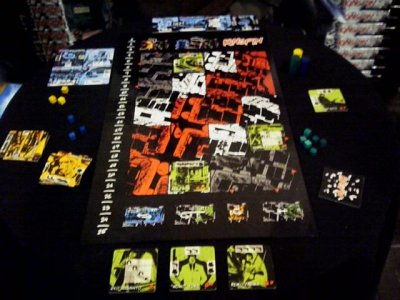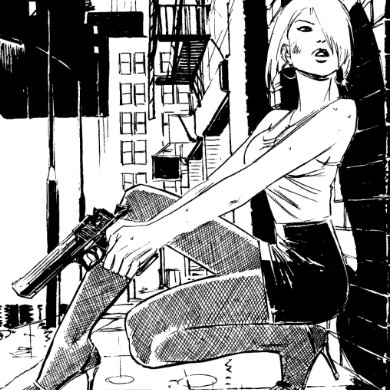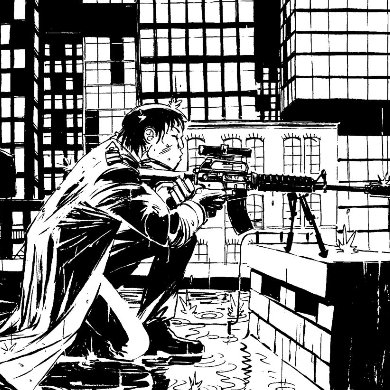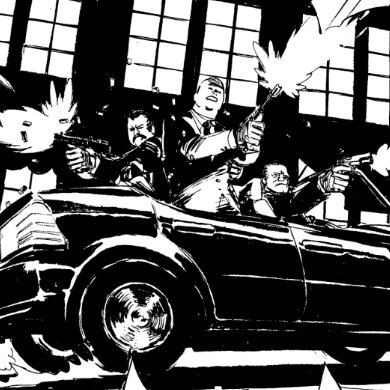![[Headline]](../technik/sonstige/headtran.gif)
![[Headline]](../technik/sonstige/headtran.gif)
![[IMAGE]](../bilder/kingpin1.jpg) |
Authors: Publisher: No. of Players: Awards: |
![[IMAGE]](../technik/box/rot/rot-5.gif) ![[IMAGE]](../technik/box/gelb/gelb-8.gif) ![[IMAGE]](../technik/box/grun/grun-9.gif) ![[IMAGE]](../technik/box/pink/pink-10.gif) ![[IMAGE]](../technik/box/blau/blau-8.gif) |
|
Kingpin first attracted my attention with its rather unusual, dark-looking comic artwork. There have been a few boardgames with dealt with the theme of gangsters and the Mafia over the years, and among these titles were games like Supergang, King of Chicago or Gangster. However, none of these games looked as thoroughgoing dark and sinister as Kingpin, and so the players in this game do not lose time with any kind of cover-up business, but they enter a bloody mob-war right away. The game is a pure two-player game, but actually three different Mafia organisations are included which can be chosen by the players. Present in the game are the Italian Mafia, the Yakuza and the Russian Mafia, and each of these gangs consists of a choice of eight different gangster tiles which are handed to the player who has chosen the organisation. Three starting gangsters are sorted out by each player, and the remaining tiles are shuffled into decks from which a new tile is revealed whenever a player has brought one of his three starting tiles (or a follow-up tile) into the game.  The gameboard shows a city quarter which both players try to control by means of force, and so each of the players is assigned an area of influence in which new gangsters can be placed. Between both areas of influence is no man's land, and it is the aim of the players either to occupy a space beyond the opponent's area of influence with one of their gangsters, or to gain control of no mans land by occupying it with three gangsters and removing all opposing gangsters. The whole game is governed by the turning and positioning of the gangster tiles, since it is the relative position of the tiles to each other which will determine the outcome of attacks and whether an opponent's gangster can be removed. To indicate the abilities of a gangster the game knows five different special abilities, and usually one or more ability symbols can be found on the different outer borders of each gangster tile. Thus, an ability only comes to bear against an opponent if the gangster points towards the opposing gangster with a side displaying a symbol of the desired attribute, and the amount of attribute symbols present on the gangster tile indicates the effectiveness of the gangster when using this attribute.  The easiest constellation here is a gun, since a gangster who points with one or more of the gun attribute symbols towards an opposing gangster on an adjacent square attacks that gangster with his attack strength equalling the number of the gun symbols. If equal or more gun symbols are used than the victim's toughness, the attacked gangster is defeated and removed from the game. However, the victim also will be checked if he actually points guns towards the attacker, and so there is a chance that the attacker may be removed as well be the simultaneous counterattack of the victim. As a matter of fact, the just given example only represents the most simple of all combat situations, and regularly combat gets much more complex due to the fact that several gangster tiles may be involved in a combat at the same time. Thus, all further opposing gangsters next to either the attacker or his victim will join in and start to shoot at the attacker or the victim as well, provided they have gun symbols turned into the right direction. These gun symbols all will add up to a grand total, and so an attack with more than one gangster actually may have a better chance to eliminate a tough gangster of the opponent.  Additional help may be provided through the use of a sniper or through support symbols. The ability to act as a sniper is different from other abilities in so far as it is not printed on the outer border but in the middle of a gangster tile, and depending on the facing of the gangster it shows a map which spaces on the gameboard which the sniper is covering with his fire. An opposing gangster standing on a space within a sniper's range of fire is considered to be dealt one additional wound in case the gangster is attacked. The support symbols once again are printed on the outer border of a gangster tile, and if a border bearing such a symbol faces a friendly gangster on an adjacent square that gangster is considered to receive support, adding one gun symbol on every side of that gangster tile as long as the gangster is supported. Damage can be reduced if a gangster has one or more guard symbols on a side facing an attacker, and each guard symbol cancels out one attack symbol so that there is a chance that there are not enough gun symbols to eliminate the lucky victim. However, as you can see, a chance to survival in Kingpin most depends on the correct placement and facing of a player's gangster tiles. The rules feature a short list of actions which are available to a player during his turn, and on the one hand are the four different movement actions (placement of a new gangster tile from the player's mob, turning of a gangster tile, moving a gangster tile or exchanging positions of two adjacent, friendly gangster tiles) which can be used for adding new gangsters or moving gangsters on the gameboard. The fifth and last possible action is an attack, and this results in a combat between two adjacent gangsters of both players, with the possible involvement of additional gangsters who either join the shooting or offer support. Taking alternating turns, a player may chose one of the above actions during his turn before the other player gets a turn, and so the game quickly passes to and fro between the players. However, there might have been a risk of long stalemates with players moving their tiles back and forwards if the designers at KUZNIA GIER had not added a limit on the playing duration, and in place of Kingpin this limit is implemented by an action track featuring 25 steps. Each time a player uses his turn for a movement action means that he will have to move his token one space on the action track after his movement action, and the first player to reach the final space of the action track will loose the game because he runs out of time. An attack action does not cost time, but an attack only may be chosen if the constellation on the gameboard actually leads to the eliminating of the victim (with the possibility of additional losses for both players due to the simultaneous killing of the attacker or other involved gangsters). While variant rules actually suggest to play without the action track in order to get an even more strategic game, Kingpin draws much of its intensity from the use of the track, since there will always be a player who must fear to be the first one to reach the final space of the track. Thus, time-wasting is heavily penalized in Kingpin, and since nobody can afford the risk of the other player getting the upper hand, both players actively try to win the game by fulfilling one of the two victory conditions.  Yet not mentioned and quite nasty is the fifth and final ability which a gangster may possess, and so some of the gangster tiles feature one or more car symbols around their outer borders. The car is used for a raid, and the conduct of a raid actually is a fuse both of a movement and an attack, since a player may move and attack with the gangster used for the raid in the same turn. This allows a quick thrust out of the distance, and so a gangster with the raid ability is difficult to kill if he is facing towards an approaching attacker with gun symbols. Kingpin is merciless and brutal not only considering its background topic but also in terms of playing time and direct action. The two players' areas of influence in which they place their new gangsters are rather close to each other, and so an exchange of blows develops at in incredible pace. I have played the game three times in a row and needed less than an hour for all three rounds, and I guess that the players even get quicker once they have learned to handle the different situations in the game with more experience. Leaving the random drawing of additional gangsters aside (variant rules say that the players can chose from all eight gangsters right from the beginning), the game includes no factor of luck, but instead offers a very strategic, chesslike challenge. Considering the fitting artwork and a few additional details like the different ways in which each Mafia organisation can be operated due to shifting abilities of the gangsters, my conclusion is that Kingpin is a very good example how a set of very abstract rules still can be backed with an interesting theme. The only minor point of possible criticism I can see is not directly game related, but it is the price of 25 Euros which seems a bit steep for a gamebox containing a double-sided gameboard, 24 gangsters, 15 wooden playing pieces and a CD with a flash intro. However, for me Kingpin was a thrilling early start into the SPIEL 09, and so I took a copy home with me despite of the somewhat high price. And as I was told by the people of KUZNIA GIER, there is a possibility that the big gamebox might fill up with more playing pieces, since they have some more Mafia organisations under development. | ||
|
| |

Looking for this game? Visit Funagain Games! |
|
|
| |
|
Impressum / Contact Info / Disclaimer Kulkmann@aol.com
Copyright © 2009 Frank Schulte-Kulkmann, Essen, Germany | |